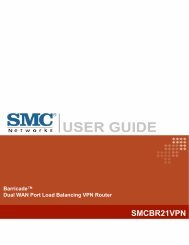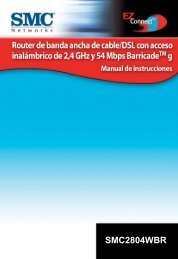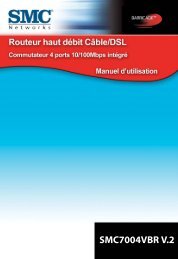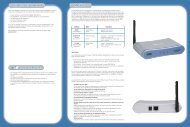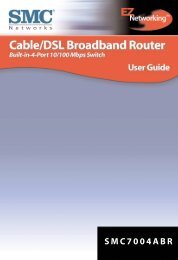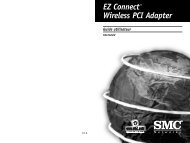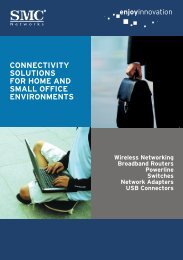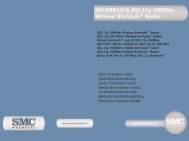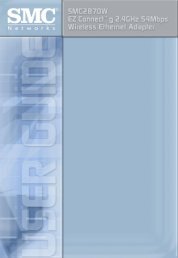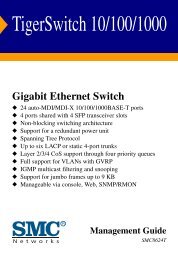INSTALLATION GUIDE Installationsanleitung - SMC
INSTALLATION GUIDE Installationsanleitung - SMC
INSTALLATION GUIDE Installationsanleitung - SMC
You also want an ePaper? Increase the reach of your titles
YUMPU automatically turns print PDFs into web optimized ePapers that Google loves.
Chapter 4: Making Network Connections<br />
Connecting Network Devices<br />
The switch units are designed to interconnect multiple segments (or collision<br />
domains). It can be connected to network cards in PCs and servers, as well as to<br />
hubs, switches or routers. It may also be connected to devices using optional SFP<br />
transceivers.<br />
If 802.3af-compliant PoE devices are connected to the switch’s 10/100 Mbps ports,<br />
the switch automatically supplies the required power.<br />
Twisted-Pair Devices<br />
Each device requires an unshielded twisted-pair (UTP) cable with RJ-45 connectors<br />
at both ends. Use Category 5, 5e or 6 cable for 1000BASE-T connections, Category<br />
5 or better for 100BASE-TX connections, and Category 3 or better for 10BASE-T<br />
connections.<br />
Power-over-Ethernet Connections<br />
The switch automatically detects an 802.3af-compliant device by its authenticated<br />
PoE signature and senses its required load before turning on DC power to the port.<br />
This detection mechanism prevents damage to other network equipment that is not<br />
802.3af complaint.<br />
Note: Power-over-Ethernet connections work with all existing Category 3, 4, 5, 5e or 6<br />
network cabling, including patch cables and patch-panels, outlets, and other<br />
connecting hardware, without requiring modification.<br />
The switch delivers power to a device using wire pairs in the connecting Ethernet<br />
cable. The switch can provide up to 15.4 W of power continuously on each 10/100<br />
Mbps port. However, taking into account some power loss over the cable run, the<br />
amount of power that can be delivered to a terminal device is 12.95 W. If a device<br />
draws more than 15.4 W, from a port, an overload condition occurs and the port<br />
turns off the power.<br />
The switch controls the power and data on a port independently. Power can be<br />
requested from a device that already has a data link to the switch. Also, the switch<br />
can supply power to a device even if the port’s data connection has been disabled.<br />
The power on a port is continuously monitored by the switch and it will be turned off<br />
as soon as a device connection is removed.<br />
4-1



